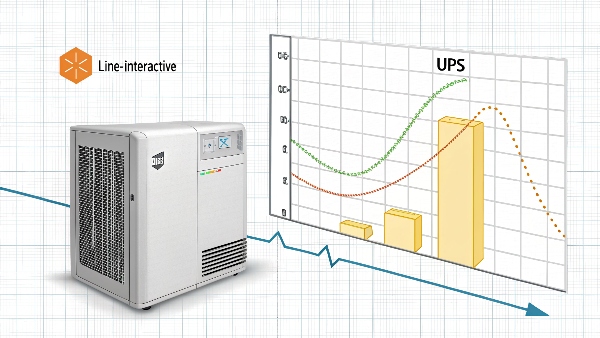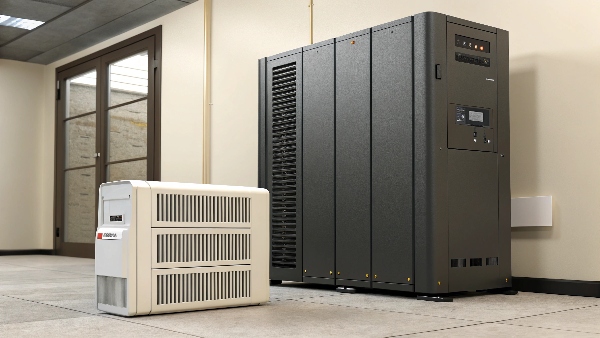You're hearing about AC and DC UPS systems. You want to know how they differ and if they can truly power everything from your AC to your lights.
AC UPS systems output AC power for standard appliances. DC UPS systems output DC power, typically for telecom or specific industrial gear. Both protect against power interruptions effectively.

At DAOPULSE, with our decade of experience in manufacturing uninterruptible power supplies, we've seen the confusion between AC and DC UPS systems arise many times. My core insight is that the range of applications for uninterruptible power supplies is very broad, suitable for home, office, and more. Whether it's an AC or DC type, the fundamental goal is reliable power. Let's break down what these categories mean and what they can do for you.
Can we use UPS as a stabilizer for AC?
Your area has unstable power, and you're worried about your air conditioner. You're wondering if a UPS can double as a voltage stabilizer to protect your AC unit.
Yes, Line-Interactive and Online UPS types act as excellent voltage stabilizers for AC units, provided the UPS is powerful enough to handle the AC's load and has a pure sine wave output.

Voltage instability, such as sags (brownouts) or swells (over-voltage), can indeed damage or shorten the lifespan of an air conditioner's sensitive motor and electronics. A UPS can help, but the type matters:
- Standby (Offline) UPS: This basic type only switches to battery during an outage. It offers minimal to no voltage regulation while on mains power. It's not ideal as a stabilizer.
- Line-Interactive UPS: This type includes an Automatic Voltage Regulator (AVR). It actively corrects low or high input voltage without switching to battery, making it a good stabilizer.
- Online (Double-Conversion) UPS: This type constantly reconstructs the AC power from the battery supply (which is continuously charged). It provides the highest level of voltage stabilization and protection.
For an air conditioner, you need:
- A Line-Interactive or Online UPS: For effective voltage stabilization.
- Sufficient Capacity: The UPS must handle the AC's high startup (inrush) current and its continuous running wattage. This often means a large, expensive UPS.
- Pure Sine Wave Output: Motors run best on pure sine wave power. Simulated sine wave from a cheaper UPS can cause issues.
My insight is that the range of applications for uninterruptible power supplies is very broad, suitable for home, office, and more. Using a correctly specified Line-Interactive or Online UPS as a stabilizer for an AC unit is a valid application, especially if you also want battery backup. However, for stabilization only, a dedicated high-power AVR might be a more cost-effective solution if battery backup for the AC isn't a priority.
Can a UPS battery backup power a heater window unit?
Winter is coming, and power outages are a concern. You're thinking a UPS might keep your small window heater running, providing essential warmth during a blackout.
Technically yes, if the UPS is extremely large and powerful. However, electric heaters draw massive amounts of power, making it impractical and very expensive for most UPS systems.

Electric heaters, much like air conditioners (but sometimes even more demanding in continuous wattage), are very power-hungry appliances. They are resistive loads, meaning they convert almost all electrical energy directly into heat.
Consider the power consumption:
- A small space heater can easily draw 1000W to 1500W.
- A window heater unit might be in a similar range or higher.
To power such a device with a UPS:
- High Wattage Rating: The UPS would need a continuous output rating exceeding the heater's wattage. For a 1500W heater, you'd need at least a 2000VA or 3000VA (often rated around 1800W-2700W) UPS, possibly more to be safe.
- Massive Battery Capacity: Running a 1500W load for even 30 minutes would require a very substantial battery bank, far larger and more expensive than what's found in typical home or office UPS units. For an hour, the battery size and cost would be enormous.
- Cost-Effectiveness: The cost of a UPS and battery system capable of running a heater for any meaningful duration would likely far exceed the cost of alternative heating solutions for outages (like propane heaters, wood stoves, or even just warm blankets and clothing).
My insight is that while the range of applications for uninterruptible power supplies is very broad, powering high-draw resistive loads like electric heaters is generally not one of their practical strengths due to the sheer energy required. While technically possible with a large enough system we at DAOPULSE could design, it's usually not an economical choice for home users.
What is the purpose of a UPS (uninterruptible power supply)?
You see UPS devices everywhere, from offices to homes. You want to understand their fundamental role: what exactly are they designed to do for your electronics?
The primary purpose of a UPS is to provide short-term, clean battery power to connected equipment during utility power failures, preventing data loss, hardware damage, and operational downtime.

An uninterruptible power supply serves several critical functions to protect and support your electronic equipment:
- Backup Power During Outages: This is its most well-known function. When the main utility power fails (blackout), the UPS instantly switches to its internal battery, providing power to your connected devices. This gives you time to save your work and shut down equipment gracefully, or for critical systems to continue operating for a period.
- Protection from Power Surges and Spikes1: Most UPS units include surge suppression circuitry. This protects your sensitive electronics from sudden, damaging voltage increases that can occur due to lightning strikes, grid switching, or other disturbances.
- Voltage Regulation2 (in many types): Line-Interactive and Online UPS models actively regulate incoming voltage. They smooth out sags (brownouts) and swells (over-voltage) without switching to battery, providing cleaner, more stable power to your devices. This prolongs equipment life.
- Frequency Regulation (in Online UPS): Online UPS systems can also correct variations in AC power frequency, which is important for some highly sensitive equipment.
- Noise Filtering: UPS systems filter out electromagnetic interference (EMI) and radio frequency interference (RFI) from the power line, which can cause glitches or errors in electronic devices.
My insight is that the range of applications for uninterruptible power supplies is very broad, suitable for home, office, and more. From protecting a single home PC to ensuring a data center stays online, the core purpose is always about providing reliable, clean power when the utility supply falters or becomes problematic.
Can I use UPS for my TV elect fan and lights?
You're looking for a simple backup solution for common household items. You're wondering if a standard UPS can keep your TV, an electric fan, and some lights running during a power outage.
Yes, you can use a UPS for a TV, electric fan, and LED/CFL lights. Calculate their total wattage, choose a UPS with sufficient capacity, and consider a pure sine wave model for the fan's motor.

Yes, a UPS can certainly be used to power a television, an electric fan, and lights, provided you choose an appropriately sized unit. Here's how to approach it:
-
Calculate Total Load:
- TV: Check the power rating (in watts) on the back of your TV or in its manual. A modern LED TV might use 50-150W.
- Electric Fan: A typical pedestal or desk fan might use 30-75W.
- Lights: LED or CFL bulbs are very efficient. A 10W LED bulb is equivalent to an old 60W incandescent. Sum the wattage of the bulbs you want to power. Avoid using a UPS for old incandescent bulbs as they are very power-hungry.
Add these wattages together to get your total load. For example: TV (100W) + Fan (50W) + 2x LED Lights (2x10W=20W) = 170W.
-
Choose UPS Capacity: Select a UPS with a watt rating that is at least 20-25% higher than your total load to provide some headroom. For a 170W load, a UPS rated for 250-300W or more (e.g., a 500VA-750VA unit) would be suitable.
-
Consider Waveform for the Fan: Electric fans have motors. Motors run best and quietest on a pure sine wave output. While a fan might run on a simulated sine wave UPS, it could buzz or run hotter. For longevity and quiet operation, a pure sine wave UPS is preferable if a fan is a key load. TVs and LED/CFL lights are usually fine with simulated sine wave.
-
Estimate Runtime: The UPS specifications will give an estimated runtime for a given load. The lower your total wattage, the longer the UPS will last.
My insight is that the range of applications for uninterruptible power supplies is very broad, suitable for home, office, and more. Powering essential home comforts like a TV, fan, and lights during an outage is a very practical use case for a well-chosen UPS. At DAOPULSE, we offer solutions that can cater to these everyday needs.
Conclusion
UPS systems, in AC or DC variants, offer versatile power protection. They can stabilize voltage for AC units and power home essentials, making them broadly applicable for both home and office needs.

